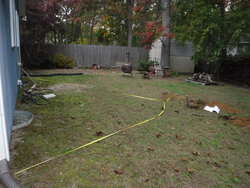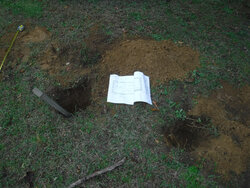Need some help figuring out some details on my septic tank.
I pulled the original plans for the septic tank system for my house submitted to the building department so I could find my tank and have it pumped. I don't know much about septic systems so please bare with me.
I have never had the tank pumped and don't know if the previous owner did it either. So lets assume it hasn't been pumped in 10 years. The system works fine, no issues with any of the drains in the house. I am just trying to be proactive. I have been using those little septic tank bio treatment bags that you flush down the toilet.
Anyway, the plans say the system was built in 1972. It has 1 rectangular septic tank (900 gallons, precast) that feeds 2 round cesspools (block).

I pulled out the tape measures and started digging. 3 holes later I think I hit the top of the septic tank. It was getting late so I had to stop.


It's about 24" inches below ground.
My questions are:
1) How much do I dig out? Until I find a manhole cover? Any other inspection ports I should look for?
2) Do I want to look for anything else?
3) When I have it pumped, any other maintenance items I should have done while it is open?
4) Also, I am assuming only the septic tank gets pumped and not the cesspools, correct?
Thank you all who read this.
I pulled the original plans for the septic tank system for my house submitted to the building department so I could find my tank and have it pumped. I don't know much about septic systems so please bare with me.
I have never had the tank pumped and don't know if the previous owner did it either. So lets assume it hasn't been pumped in 10 years. The system works fine, no issues with any of the drains in the house. I am just trying to be proactive. I have been using those little septic tank bio treatment bags that you flush down the toilet.
Anyway, the plans say the system was built in 1972. It has 1 rectangular septic tank (900 gallons, precast) that feeds 2 round cesspools (block).

I pulled out the tape measures and started digging. 3 holes later I think I hit the top of the septic tank. It was getting late so I had to stop.


It's about 24" inches below ground.
My questions are:
1) How much do I dig out? Until I find a manhole cover? Any other inspection ports I should look for?
2) Do I want to look for anything else?
3) When I have it pumped, any other maintenance items I should have done while it is open?
4) Also, I am assuming only the septic tank gets pumped and not the cesspools, correct?
Thank you all who read this.
Last edited:


